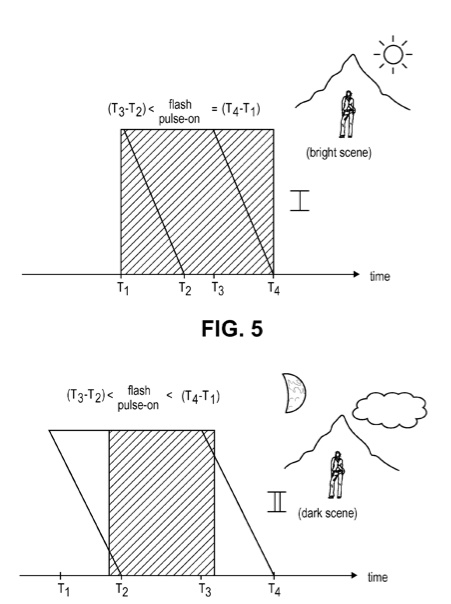A new Apple patent (number 20110317991) at the US Patent & Trademark Office shows that the company is eyeing ways to improve the cameras in its iOS devices. The patent is for a flash control for an electronic rolling shutter.
A scene ambient lighting indication is obtained. An integration time interval and a flash pulse-on time interval for taking a picture is then set. The set integration time interval is shorter when the indication is bright than when the indication is dark; and the set flash pulse-on time interval is longer when the indication is bright than when the indication is dark.
An image is captured using the set integration time interval and the set flash pulse-on time interval in accordance with an electronic rolling shutter (ERS). Other embodiments are also described and claimed. Richard Tsai is the inventor.
Here’s Apple’s summary of the invention: “An embodiment of the invention is an electronic camera with electronic rolling shutter (ERS), having an exposure controller that can automatically set an integration time interval and a flash pulse-on time interval for a given exposure in accordance with at least two different scenarios, namely one for a ‘dark’ scene and one for a ‘bright’ scene.
“Note that the references to dark and bright are only relative to each other and are not otherwise limiting. In both of those scenarios, the camera has determined (either automatically or via manual user input) that flash illumination is to be applied when taking a picture of a particular scene. The exposure controller then automatically sets the integration time interval and the associated flash pulse width in accordance with the following algorithm: the integration time interval is shorter when the indication is bright than when the indication is dark, and the flash pulse width is longer when the indication is bright than when the indication is dark.
“This algorithm balances the need for obtaining good resolution of the foreground in the scene and minimizing the flash mechanism’s power consumption, while taking advantage of a flash mechanism that may be based on an LED lamp, rather than a gas discharge lamp.
“The ERS has a row overlap time interval, which depends on the set integration time interval. In one embodiment of the invention, the set flash pulse width is longer than this row overlap interval when the indication is bright, and shorter than the row overlap interval when the indication is dark.
“In ERS also has an exposure complete time interval (also referred to as the image framing period) that also depends on the set integration time interval. In another embodiment of the invention, the set flash pulse width is as long as this exposure complete time interval when the indication is bright, and shorter than the exposure complete time interval when the indication is dark. In a further aspect of this embodiment, the set flash pulse width also is longer than the row overlap interval when the indication is dark.
“The above summary does not include an exhaustive list of all aspects of the present invention. It is contemplated that the invention includes all systems and methods that can be practiced from all suitable combinations of the various aspects summarized above, as well as those disclosed in the Detailed Description below and particularly pointed out in the claims filed with the application. Such combinations have particular advantages not specifically recited in the above summary.”
— Dennis Sellers

